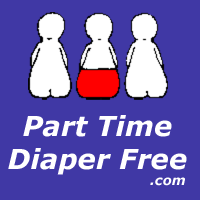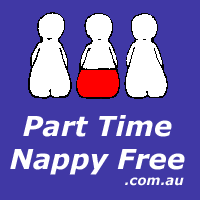Breastfeeding my Nappy Free
Baby
- an article I wrote for the ABA's
"Essence" magazine in 2006.
A key aid to practicing EC is built in – learning the language of the boobs!
My baby stirs beside me. He searches and ‘boobifies’ himself as I
gaze at his gorgeous face. A quick drink and he pulls off, frowns, squirms
and kicks his legs. I pick him up and hold him over a bowl, where he does
a big wee as I whisper "sss" quietly in his ear. He then
continues his feed for a while longer, eyes open as he fiddles with my
hair. Soon, he pulls off, goes back on, detaching and attaching in a
certain ‘plucking’ way as he again wriggles then grizzles a bit. I
hold him over the bowl again, cue ‘sss pss’, patiently waiting – he
does his daily poo as I clench my belly muscles to encourage and help him
to learn what to do. I wipe his cute little bum with a tissue. He again
goes back to feeding. Happily relaxed, he drifts off to sleep after he
finishes, flutter sucking away…
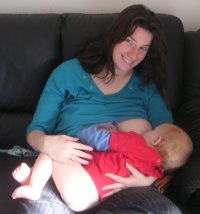 All
this happens without undressing, as my baby does not wear a nappy. This
has been a familiar scene in our breastfeeding pattern for many months
now. We have practised an ancient method of hygiene care called ‘Natural
Infant Hygiene’, ‘infant pottying’ or ‘Elimination
Communication’ (EC) since he was born. We stopped regular nappy use at
home while he was three months old, and nappies when out while he was five
months old. He wears padded underwear or knickers now, at one year old. We
hold him to do his business when he needs to go.
All
this happens without undressing, as my baby does not wear a nappy. This
has been a familiar scene in our breastfeeding pattern for many months
now. We have practised an ancient method of hygiene care called ‘Natural
Infant Hygiene’, ‘infant pottying’ or ‘Elimination
Communication’ (EC) since he was born. We stopped regular nappy use at
home while he was three months old, and nappies when out while he was five
months old. He wears padded underwear or knickers now, at one year old. We
hold him to do his business when he needs to go.
The language we use is
non-verbal at first. Over time he has begun to give vocal calls to alert
us. He is now starting to use sign language. And yes, we have
accidents! We have wet nappies, wet pants! Perfection is not the aim – communication is, keeping him
clean and dry until he takes over himself.
I wish all Mums knew this!
I cannot count the number of times giving my baby a pee break was the
solution to a fussy baby. Especially when breastfeeding, if he stopped
during a feed, popping on and off, or refusing to stay attached, once he
had a pee break, he'd continue happily. If he was grizzly and squirmy at
other times, very often it was the need to poo making him uncomfortable -
after a good 'go', he'd simply go to sleep! I wish every Mum knew this
simple option to help baby through a fussy patch - holding baby in
position to gain some relief. It was empowering for my confidence, knowing
one more way to respond to and HELP my baby. Saving nappies is secondary
to this wonderful benefit - communicating with my baby.
Breastfeeding is inextricably linked with our EC practise. I hold the
baby close to my heart to nurture his soul and nourish his belly, helping
him to ‘go’ in a bowl, rather than a nappy. Our ‘elimination
communication’ began with breastfeeding. The first sign I learnt was him
pulling off and on the breast during a feed – a pretty common feeding
behaviour – which signals baby’s instinct not to ‘eat’ and
‘go’ at the same time. He simply refuses to breastfeed if a full
bladder distracts him. It grew from there to become an integral part of
our lifestyle, day and night, just as breastfeeding is. He breastfeeds, he
pees, every time. It is heaps of fun!
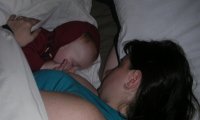 Like
breastfeeding, the early days of EC takes practise, commitment; time spent
learning signs and cues, doubting confidence, asking questions and gaining
the courage to persevere. Like breastfeeding, the benefits are many –
there are daily rewards, it gets easier, yet there are always ongoing
challenges and fun times as my baby (and my confidence) grows. We’re
both constantly learning, changing, adapting as we work in concert
together.
Like
breastfeeding, the early days of EC takes practise, commitment; time spent
learning signs and cues, doubting confidence, asking questions and gaining
the courage to persevere. Like breastfeeding, the benefits are many –
there are daily rewards, it gets easier, yet there are always ongoing
challenges and fun times as my baby (and my confidence) grows. We’re
both constantly learning, changing, adapting as we work in concert
together.
Just as weaning is not the aim of breastfeeding, it is the bonding,
nurturing, nutrition, and protection it confers - with EC, the aim is to
care for baby’s hygiene needs in the present moment –
‘now’, rather than later when it is perhaps more convenient to me. I
find it much easier than using nappies. The focus is on learning his body
language signs for ‘going’ as I learn his hungry and sleepy signs.
Amazingly quickly he was clearly communicating his toilet needs, although
not every time! That’s ok, like tumbling when learning to walk. He does
his best, and so do I!
EC is an entirely different approach to baby hygiene. Toilet
independence is merely the result of a natural process of development and
practise from birth, just as weaning is the natural result of a
breastfeeding relationship. The baby does not require ‘toilet
training’ as their natural awareness is nurtured through infancy and
beyond. All babies have the instincts that my baby has. We can practise
and encourage this awareness, ‘tuning in’ to these instincts during
their early months before they fade and baby ‘learns’ to go only into their
nappy by five to six months.
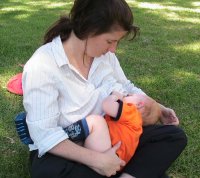 In
one end and out the other!
In
one end and out the other!
Breastfeeding and practising ‘natural infant hygiene’ together has
helped me to learn many things about my baby. Here are several
things:
-
I learnt holding and carrying my baby was the best way to learn his
signs to keep him clean and dry. One more reason why baby wearing is
so beneficial! Holding him close allows easy access to his favourite
food portals, too. We hold babies while breastfeeding, so we can be in
tune with their needs. We can also learn to help them eliminate while
holding them.
-
I learnt babies don’t like to ‘soil the nest’. During our
nightly breastfeeding moments I could hold him to wee, then continue.
He seldom wore a nightly nappy beyond three months, rousing to feed
then pee as I helped him before he really even woke – his wiggling
and breathing lets me know. Then he sleeps soundly. We had a bed mat
he slept on to protect the sheets from ‘misses’ until he was 8
months.
-
I learnt that I would be breastfeeding for far longer than my baby
would be in nappies, instead of the other way
around. He would be
relying on me rather than a product for both his
nutrition and his hygiene needs in infancy.
-
I learnt he has a sensitivity to wheat if I have too much bread or
pasta in a day – he will pee copious amounts a few hours later every
ten minutes until it clears his system, and he will get stressed.
-
I learnt to know when he was teething as his peeing increased and he
would also poop more often as well as breastfeeding extra frequently
day and night. I also learnt when he first had teeth to pay careful
attention to his ‘mid feed’ signs so I wasn’t ‘nipped’ to
pay attention and give him a pee-break!
-
I learnt to very slowly introduce family foods to add to his
breastfeeding. I wanted his system to slowly get used to the sensation
changes as his bowel muscles strengthened naturally through EC. Poops
are pretty easy for him. It’s also fabulous not dealing with
blow-outs!
Five key points
-
EC takes daily practise and evolves with the baby’s skills and
development (and your own). It is gentle and takes patience and
consistency. It can be done with full-time nappy use, or part-time
when parents are able, for even one hour a day. (One less nappy a day
means 365 fewer changes a year at least!)
-
EC is supported by 'paediatric'
(supporting baby's cues), also known as 'natural' or ‘attachment’ parenting practices such as
breastfeeding on cue, baby wearing, responding promptly to baby, sleep
sharing, a baby-Led
introduction to solids and natural or cooperative weaning.
If you’d like to expand your breastfeeding relationship to experiment
with some nappy free time, or to learn another way to respond to a
‘fussing’ baby, simply start observing and being aware as you learn
more about this ancient, primal, wonderful and addictive way of caring for
baby's bottom end needs. EC is a great perk - less nappies to change! That is
a fantastic thing for everyone involved!
Most of this article appeared in the September 2006 Issue of
"Essence" - the magazine of the Australian
Breastfeeding Association. I trimmed out parts that are repeated
elsewhere in Tribal Baby, and added in the parts that couldn't fit into
the magazine.
Discover More About Part Time Elimination Communication (EC)
Click on the appropriate banner
below to see how EC can aid your breastfeeding confidence.
Back to top Tribal Baby © 2010 Charndra Josling
 Tribal Baby
Tribal Baby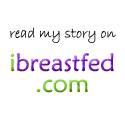
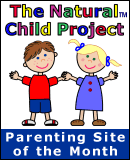
 All
this happens without undressing, as my baby does not wear a nappy. This
has been a familiar scene in our breastfeeding pattern for many months
now. We have practised an ancient method of hygiene care called ‘Natural
Infant Hygiene’, ‘infant pottying’ or ‘Elimination
Communication’ (EC) since he was born. We stopped regular nappy use at
home while he was three months old, and nappies when out while he was five
months old. He wears
All
this happens without undressing, as my baby does not wear a nappy. This
has been a familiar scene in our breastfeeding pattern for many months
now. We have practised an ancient method of hygiene care called ‘Natural
Infant Hygiene’, ‘infant pottying’ or ‘Elimination
Communication’ (EC) since he was born. We stopped regular nappy use at
home while he was three months old, and nappies when out while he was five
months old. He wears  Like
breastfeeding,
Like
breastfeeding,  In
one end and out the other!
In
one end and out the other!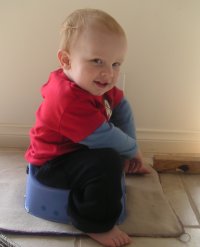 EC
is fun and rewarding every day! Each day I think my baby is a genius.
The environment benefits with less ‘disposables’ in dumps, and
less water use. It is a way to reduce nappy use naturally.
EC
is fun and rewarding every day! Each day I think my baby is a genius.
The environment benefits with less ‘disposables’ in dumps, and
less water use. It is a way to reduce nappy use naturally.
